1998 CHEVROLET PRIZM oil level
[x] Cancel search: oil levelPage 173 of 364
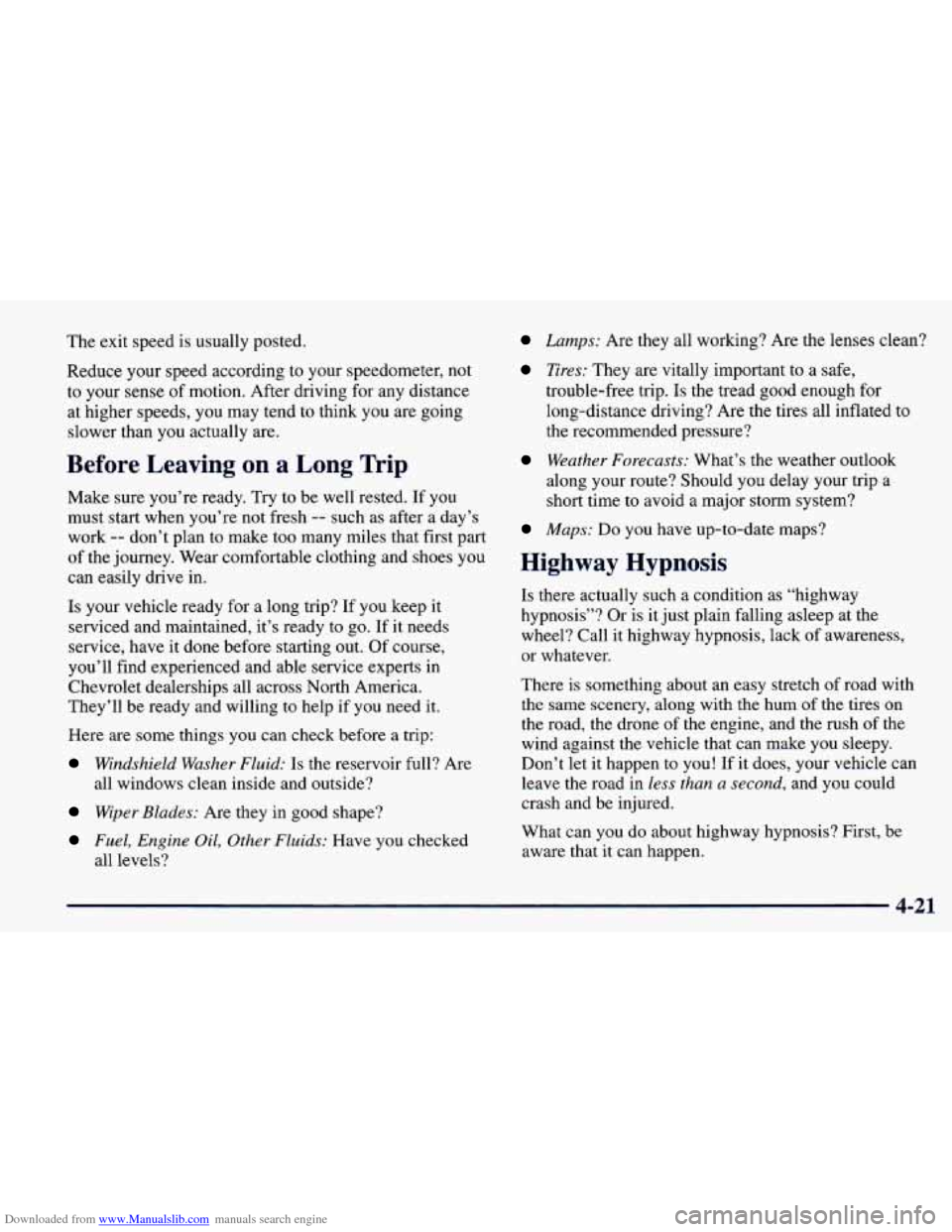
Downloaded from www.Manualslib.com manuals search engine The exit speed is usually posted.
Reduce your speed according to your speedometer, not to your sense of motion. After driving for any distance
at higher speeds, you may tend to think you are going
slower than you actually are.
Before Leaving on a Long Trip
Make sure you’re ready. Try to be well rested. If you
must start when you’re not fresh
-- such as after a day’s
work
-- don’t plan to make too many miles that first part
of the journey. Wear comfortable clothing and shoes you
can easily drive in.
Is your vehicle ready for a long trip? If you keep it
serviced and maintained, it’s ready to go. If it needs
service, have it done before starting out. Of course,
you’ll find experienced and able service experts in
Chevrolet dealerships all across North America.
They’ll be ready and willing to help if you need it.
Here are some things you can check before a trip:
Windshield Washer Fluid: Is the reservoir full? Are
all windows clean inside and outside?
Wiper Blades: Are they in good shape?
Fuel, Engine Oil, Other Fluids: Have you checked
all levels?
Lamps: Are they all working? Are the lenses clean?
Tires: They are vitally important to a safe,
trouble-free trip.
Is the tread good enough for
long-distance driving? Are the tires all inflated to
the recommended pressure?
Weather Forecasts: What’s the weather outlook
along your route? Should you delay your trip a
short time to avoid
a major storm system?
Maps: Do you have up-to-date maps?
Highway Hypnosis
Is there actually such a condition as “highway
hypnosis”? Or is it just plain falling asleep at the
wheel? Call
it highway hypnosis, lack of awareness,
or whatever.
There is something about an easy stretch of road with
the same scenery,
along with the hum of the tires on
the road, the drone of the engine, and the rush of the
wind against the vehicle that can make you sleepy.
Don’t let it happen to you!
If it does, your vehicle can
leave the road in
less than a second, and you could
crash and be injured.
What can you do about highway hypnosis? First, be
aware that it can happen.
4-21
Page 206 of 364

Downloaded from www.Manualslib.com manuals search engine Car --ng System
wnen you decide it’s safe to lift the hood, here’s what
you’ll
see:
A. Electric Engine Cooling Fans
B. Radiator Pressure Cap
C. Coolant Recovery Tank
An electric engine cooling fan under the hood can
start up even when the engine
is not running and
can injure you. Keep hands, clothing and tools
away from any underhood electric fan.
If the coolant inside the coolant recovery tank is boiling,
don’t
do anything else until it cools down.
The coolant level should
be at or above
FULL.
If it isn’t, you may have a leak in the radiator hoses,
heater hoses, radiator, water pump
or somewhere else in
the cooling system.
5-16
Page 207 of 364
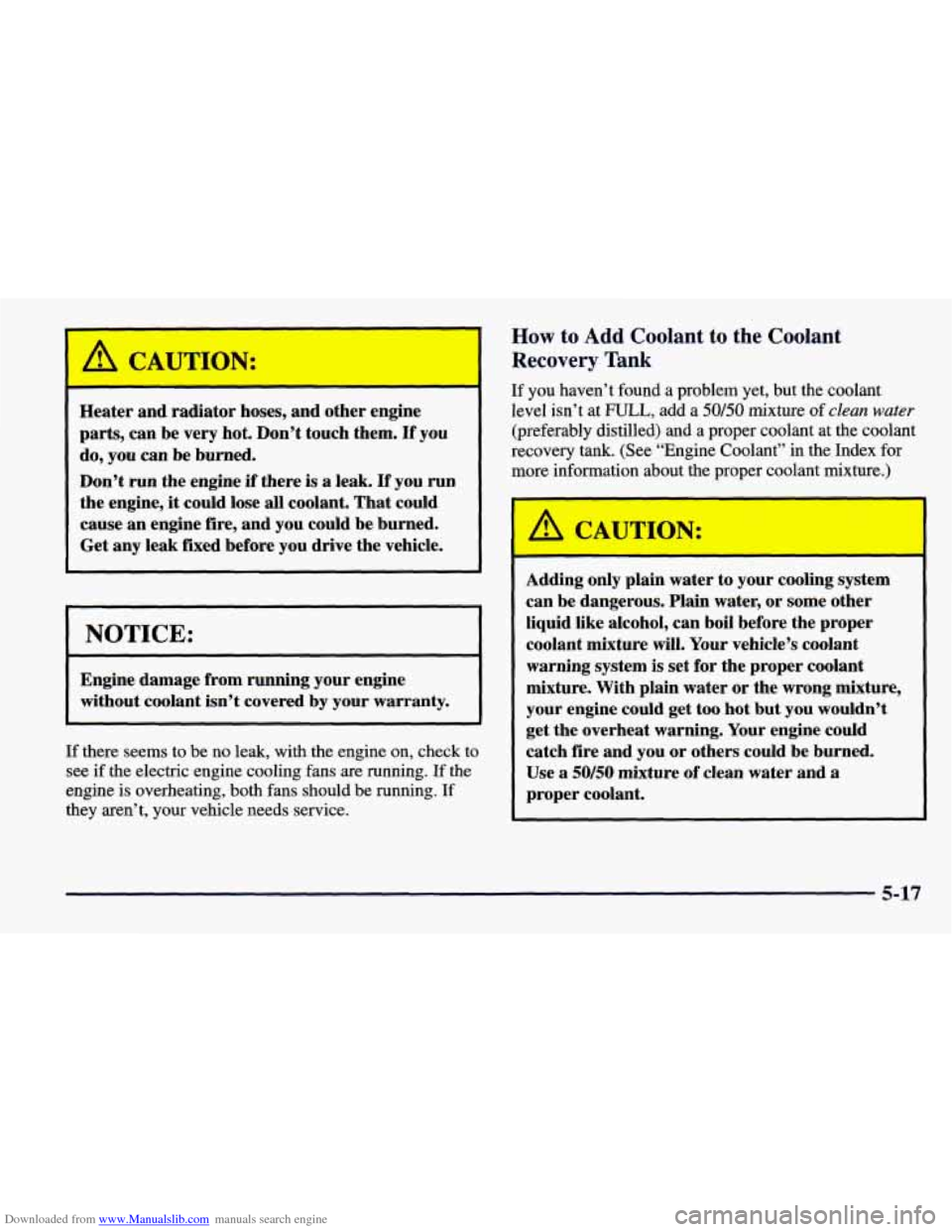
Downloaded from www.Manualslib.com manuals search engine A CAUTION:
Heater and radiator hoses, and other engine
parts, can be
very hot. Don’t touch them. If you
do, you can be burned.
Don’t run the engine if there is a leak.
If you run
the engine, it could lose all coolant. That could
cause an engine fire, and you could be burned.
Get any leak fixed before you drive the vehicle.
NOTICE:
Engine damage from running your engine
without coolant isn’t covered by your warranty.
If there seems to be no leak, with the engine on, check to
see if the electric engine cooling fans
are running. If the
engine is overheating, both
fans should be running. If
they aren’t, your vehicle needs service.
How to Add Coolant to the Coolant
Recovery Tank
If you haven’t found a problem yet, but the coolant
level isn’t at
FULL, add a 50/50 mixture of clean water
(preferably distilled) and a proper coolant at the coolant
recovery tank. (See “Engine Coolant” in the Index for
more information about the proper coolant mixture.)
/! CAUTION:
I
Adding only plain water to your cooling system
can be dangerous. Plain water, or some other
liquid like alcohol, can boil before the proper
coolant mixture will. Your vehicle’s coolant
warning system is set for the proper coolant
mixture. With plain water or the wrong mixture,
your engine could get too hot
but you wouldn’t
get the overheat warning. Your engine could
catch fire and you or others could be burned.
Use
a 50/50 mixture of clean water and a
proper coolant.
5-17
Page 227 of 364

Downloaded from www.Manualslib.com manuals search engine 0 Section 6 Service and Appearance Care
Here you will find information about the care of your vehicle. This section begins with service and fuel information,
and then
it shows how to check important fluid and lubricant levels. There is also technical information about your
vehicle, and
a part devoted to its appearance care.
6-2
6-
3
6-5
6-6
6-
8
6-9
6-12
6-16
6-18
6-2
1
6-22 6-23
6-25
6-25
6-26
6-27
Service
Fuel
Fuels in Foreign Countries
Filling Your Tank
Filling a Portable
Fuel Container
Checking Things Under the Hood
Engine Oil
Air Cleaner
Automatic Transaxle Fluid
Manual Transaxle Fluid
Hydraulic Clutch
Engine Coolant
Radiator Pressure Cap
Thermostat Power Steering Fluid
Windshield Washer Fluid
6-28
6-32
6-33
6-37
6-44
6-45
6-47
6-47
6-48
6-53
6-53
6-5
8
6-59 6-60
Brakes
Battery
Bulb Replacement
Tires
Appearance Care
Cleaning the Inside
of Your Vehicle
Cleaning the Built-in Child Restraint
Care of Safety Belts and Built-in Child
Restraint Harness
Cleaning the Outside of Your Vehicle
Vehicle Identification Number
(VIN)
Electrical System
Replacement Bulbs
Capacities and Specifications
Air Conditioning Refrigerants
Page 238 of 364
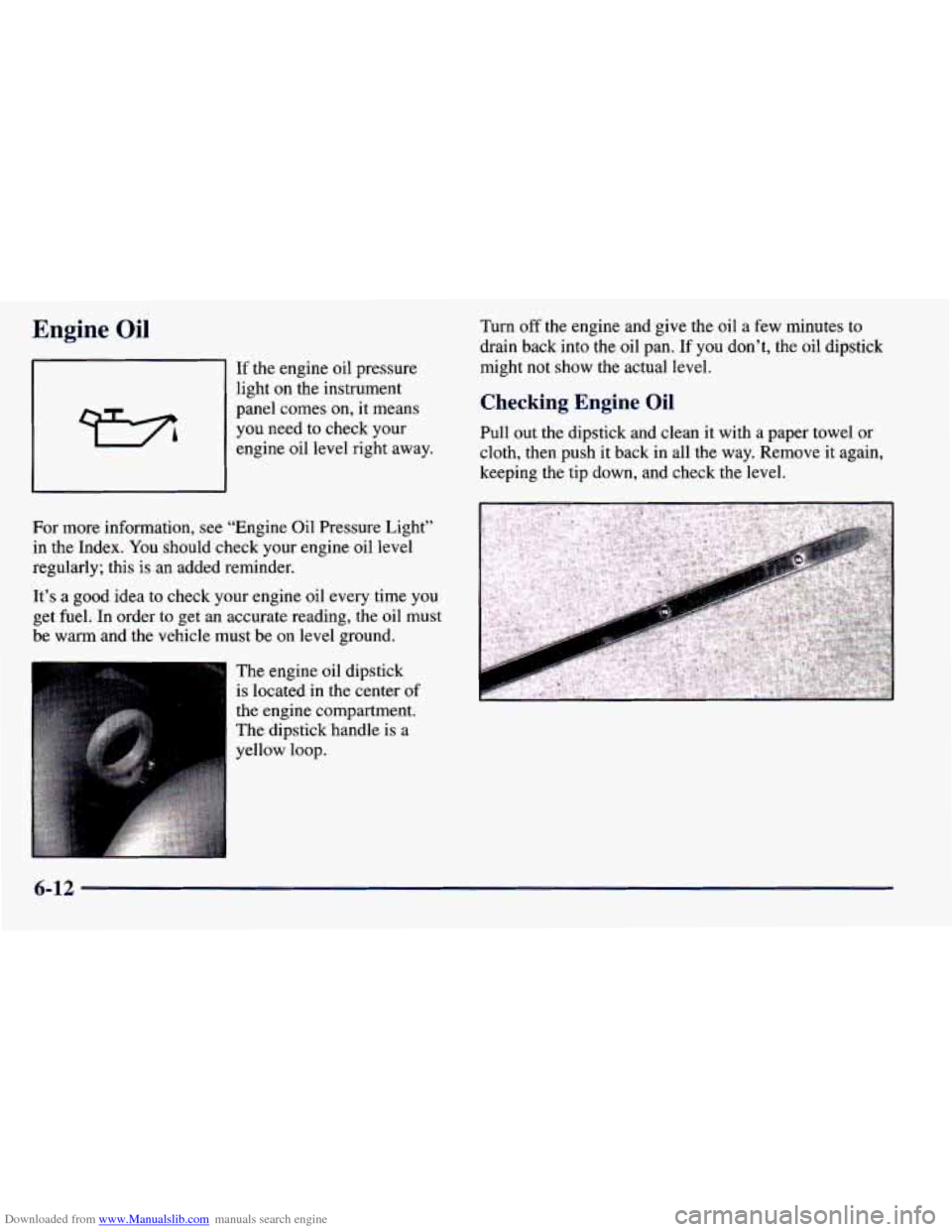
Downloaded from www.Manualslib.com manuals search engine Engine Oil
If the engine oil pressure
light
on the instrument
panel comes on, it means
you need to check your
engine oil level right away. Turn off
the engine and give the oil
a few minutes to
drain back into the oil pan.
If you don’t, the oil dipstick
might not show the actual level.
Checking Engine Oil
Pull out the dipstick and clean it with a paper towel or
cloth, then push it back in all the way. Remove it again,
keeping the tip down, and check the level.
For more information,
see “Engine Oil Pressure Light”
in the Index.
You should check your engine oil level
regularly; this
is an added reminder.
It’s a good idea to check your engine oil every time you
get fuel.
In order to get an accurate reading, the oil must
be warm and the vehicle must
be on level ground.
. .. .,
The engine oil dipstick
is located in the center of
the engine compartment.
The dipstick handle
is a
yellow loop.
6-12
Page 239 of 364
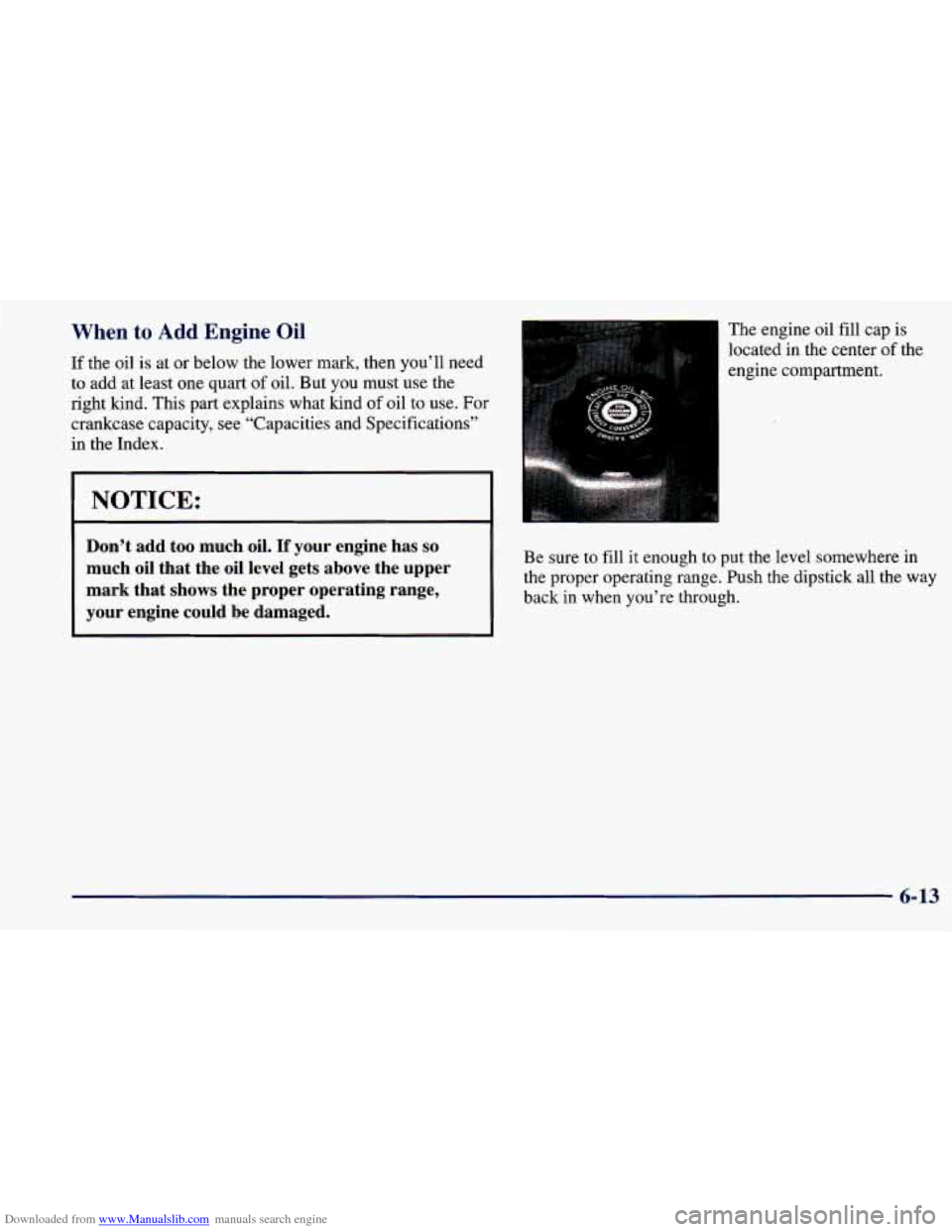
Downloaded from www.Manualslib.com manuals search engine When to Add Engine Oil
If the oil is at or below the lower mark, men you’ll need
to add at least one quart of oil. But you must use the
right kind. This part explains what kind
of oil to use. For
crankcase capacity, see “Capacities and Specifications”
in
the Index.
NOTICE:
Don’t add too much oil. If your engine has so
much oil that the oil level gets above the upper
mark that shows the proper operating range,
your engine could be damaged.
The engine oil fill cap is
located in the center of the
engine compartment.
Be sure to fill it enough to put the level somewhere in
the proper operating range. Push the dipstick all the way
back in when you’re through.
6-13
Page 244 of 364

Downloaded from www.Manualslib.com manuals search engine Automatic Transaxle Fluid
When to Check and Change
A good time to check your automatic transaxle fluid
level is when the engine oil is changed.
Change fluid in the transaxle and differential every
15,000 miles (25 000 km) if the vehicle is mainly
driven under one or more of these conditions:
In heavy city traffic where the outside temperature
regularly reaches
90°F (32°C) or higher.
0 In hilly or mountainous terrain.
When doing frequent trailer towing.
Uses such as found in taxi, police or delivery service.
If you do not use your vehicle under any of these
conditions, check the fluid.
See “Scheduled Maintenance Services’’ in the Index.
How to Check
Because this operation can be a little difficult, you may choose
to have this done at your Chevrolet dealership
Service Department.
If you do it yourself, be sure to follow all the
instructions here, or you could get a false reading
on the dipstick.
I NOTICE:
Too much or too little fluid can damage your
transaxle.
Too much can mean that some of the
fluid could come out and fall on hot engine parts
or exhaust system parts, starting a fire. Be sure to
get an accurate reading if you check your
transaxle fluid.
6-18 .-
Page 247 of 364
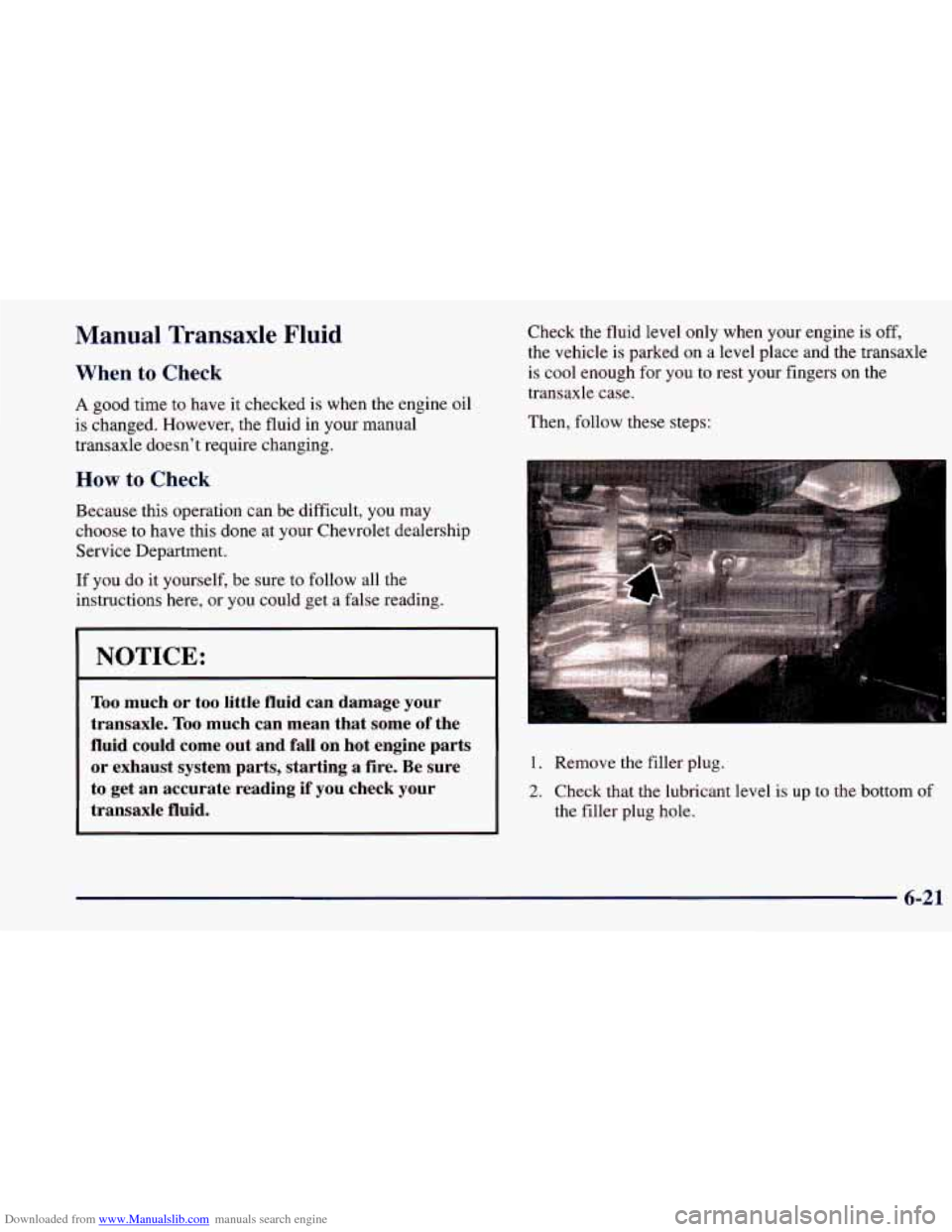
Downloaded from www.Manualslib.com manuals search engine Manual Transaxle Fluid
When to Check
A good time to have it checked is when the engine oil
is changed. However, the fluid
in your manual
transaxle doesn’t require changing.
How to Check
Because this operation can be difficult, you may
choose to have this done at your Chevrolet dealership
Service Department.
If you do it yourself, be sure to follow all the
instructions here, or you could get a false reading.
I NOTICE:
Too much or too little fluid can damage your
transaxle.
Too much can mean that some of the
fluid could come out and fall on hot engine parts
or exhaust system parts, starting a
fire. Be sure
to get an accurate reading if you check your
transaxle fluid.
Check the fluid level only when your engine is off,
the vehicle is parked on a level place and the transaxle
is cool enough for
you to rest your fingers on the
transaxle case.
Then, follow these steps:
1. Remove the filler plug.
2. Check that the lubricant level is up to the bottom of
the filler plug hole.
6-21